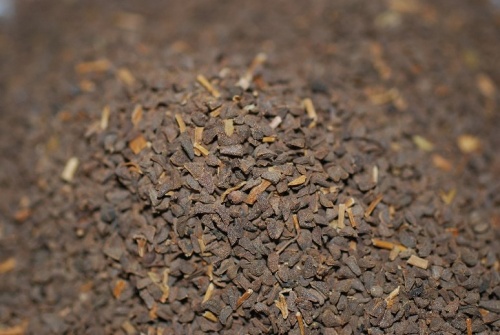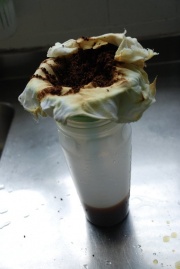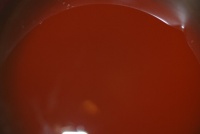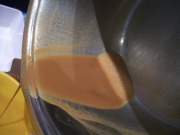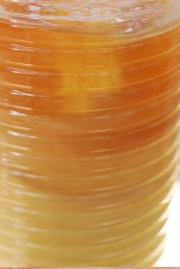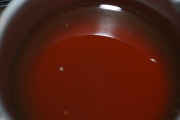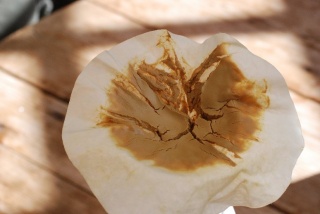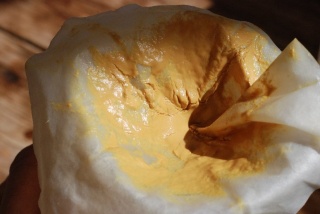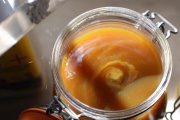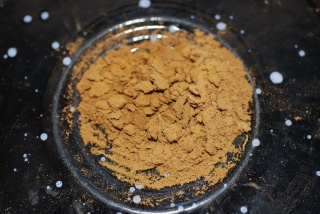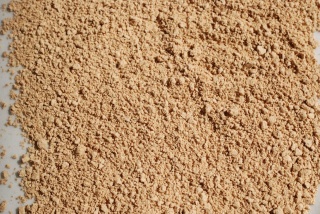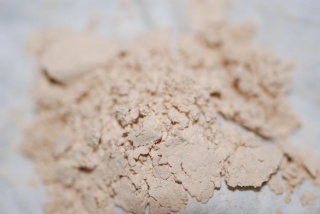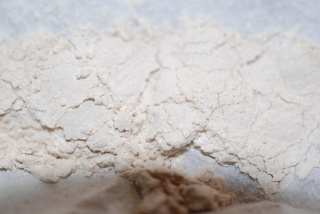Harmalas Extraction and Separation Guide
| Note: | This page is a transcription of Harmalas Extraction and Separation Guide[1]. |
Here's how you can get pure harmala alkaloids with food-safe materials.
Resumed Process
A- Boil seeds 3x, filter (discard solids)
B- Reduce, filter (discard solids)
C- Saturate with salt, filter (keep solids, discard liquid)
D- Redissolve in warm water, filter (discard solids)
Repeat C and D a few times for purifying product
E- Add sodium carbonate, filter (keep solids, discard liquid) Repeat C, D and E a couple of times for having purer product.
F- (optional) Instead of precipitating all the alkaloids in step E, first add sodium bicarbonate to precipitate harmine, then add sodium carbonate to precipitate harmaline
Contents
Step one
Grind rue seeds in blender or grinder (for the making of this guide 200 grams were used, but adjust to your desired quantity)
Step two
Boil for half an hour in water with a little dash of vinegar. No need to be exact with amount of water, just dont use too little that it forms a thick syrup, better give a bit more water space for the alkaloids to move out to.
Step three
Pour the water out and keep it in a separate container, filtering in some very coarse filter such as very loosely-put cotton on the bottom of a funnel or even better an old tshirt/cloth.
Step four
Put the seeds back in the pot, with more fresh water and dash of vinegar, and repeat steps 2-4 for a total of 3 or 4 times.
Step five
Put together the liquids from all the boils and discard the solids
Step six
Filter in a funnel with cotton plug. Be patient, it may take some minutes. It goes faster when there is a lot of liquid in the funnel to press down on the rest. If its taking much too long, filter again once or twice through a coarser cloth filter or dont pack the cotton plug so tightly.
Step seven
Repeat step 6 packing the cotton tighter for removing finer particles
Step eight
Put filtered liquid back in the pot to reduce in low fire. If you had, say, 4 liters of filtered rue tea, reduce to 1l so that its more manageable later.
Step nine
After reducing, filter again like in steps 6 and 7 because more solid impurities will have appeared in the process of reducing.
Step ten
Saturate the tea with salt. Have the tea boiling in a pot, and keep adding salt and stirring until no more salt dissolves (it will be a lot of salt, I usually dont measure because its unnecessary but it might be anywhere between 200-300g salt per liter water). Specially on this first salt precipitation, the water is too dark to see if all the salt is dissolved, so add around 200g per liter of boiling rue tea, stir for a couple of minutes, let it sit for another minute, and then pour the liquid out slowly into a new container.. If at the bottom there is any undissolved salt, just leave it behind. If there is no salt on the bottom, maybe would be a good idea to add some more salt just to make sure its completely saturated. After decanting the tea from the excess salt into a new container, put it in the fridge.(No need to be super accurate, too much salt is no problem as excess salt will be removed later). What is happening here is that with excess of salt, the harmalas get the Chlorine ions from salt and precipitate in the salt harmala form, harmine and harmaline HCl, which are insoluble in salt saturated water therefore precipitate. In this step one removes the uterotonic and possibly more toxic alkaloids vasicine and vasicinone, dangerous specially for pregnant women because they are abortifacient. Analysis done by Shulgin and others have shown salt-precipitated harmalas to be indeed free of these mentioned alkaloids.
Step eleven
Filter with a coffee filter. This time you want to keep the alkaloids so you have to use a finer filter that wont let the alkaloids pass, like a cloth or cotton might. Therefore, has to be like a coffee filter and this step may be slower. Some shortcuts can be made which is to use a vacuum filtering system, and if one cannot afford a propper one, it can be improvised at very low cost, or adapting a paper filter in a french coffee press
Step twelve
Redissolve the Harmalas HCl in warm/hot water with a bit of vinegar.
Step thirteen
Filter a couple of times with coffee filter. Now there are less impurities, so using a fine filter like coffee filter, a few times, will help getting more and more rid of the finer impurities too. Your alkaloids should be dissolved in the liquid so any solid/color that stays in the filter is impurity. A coarse filter would not be enough, needs to be coffee filter or even two stacked up. The colours change beautifully from the yellowish salt precipitation to the clear reddish colour when redissolved.
Step fourteen
Repeat steps 10-13 A few times to make product cleaner. I recommend at least 3. In the first runs it is a darker brown, and then it gets progressively lighter yellower, like in these pictures:
Step fifteen
Slowly add sodium carbonate to your redissolved harmalas. At first it might bubble from sodium carbonate reacting with acetic acid from vinegar until it neutralizes. Dont add too fast or it might bubble up and make a mess. After it stops bubbling, the colour starts changing as the pH rises and alkaloids start precipitating. Keep adding a bit of sodium carbonate even after colour stopped changing, just to make sure everything will precipitate. Let it rest for at least a couple of hours, and then filter with coffee filter.
Step sixteen
This step is only if you want to separate harmine and harmaline. For this process we use the difference in their pKa, which is basically the measure that says at a certain pH, how many of its molecules will be freebase or in salt form. Harmine becomes a freebase in a pH where most harmaline is still salt, so one can separate them. If you have accurate pH meter, at pH 8,75, 92% of harmine will precipitate while only 8% of harmaline will precipitate. Add sodium carbonate till pH 8,75 or add sodium bicarbonate freely till it stops changing colour and a bit more, to precipitate harmine. Wait at least half an hour and filter with coffee filter, and add sodium carbonate freely to precipitate harmaline. Wait at least 2 hours and then filter with coffee filter to retrieve your harmaline. Dry and enjoy :)
The more one repeats the whole process, the cleaner the alkaloids get. I recommend repeating and alternating a few times between the salt precipitation and the freebase precipitation, with more runs on the salt than on the freebase. The reason for this is because even at a high pH, it is possible that a small quantity of harmaline still does not precipitate, so every basing could lose a small amount of it. It might not be such a significant quantity but maybe if one repeated many many times one could lose some alkaloids. One could make for example 3x salt precipitation, 1x base, again 1 or 2x salt and 1 or 2x base. If one does this, this is what happens:
And after one or another clean up run, the final products can be such as this:
